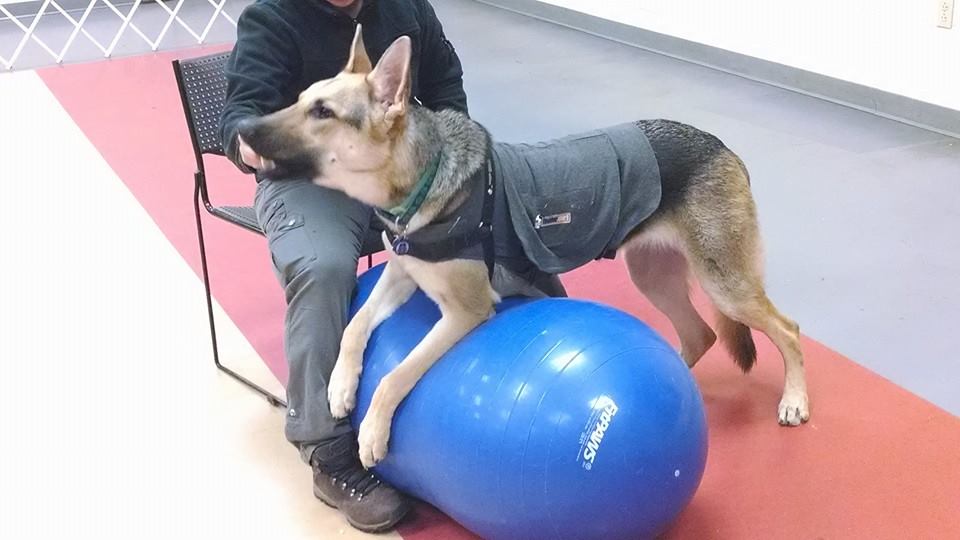By Tena Parker CPDT-KA
Success Just Clicks Dog Training
“A tired dog is a happy dog” is a phrase that nearly every dog owner is familiar with. It suggests that dogs who are tired won’t have the energy to get into trouble and while it isn’t inaccurate, it doesn’t tell the whole truth.
In many situations, I do think that phrase is quite true. Plenty of dogs that I encounter are chronically under stimulated—they are lacking appropriate amounts of physical and mental exercise. This lack of stimulation is often a contributing factor to (and in some cases, a direct cause of) problem behaviors like barking, destruction in the home or yard, inappropriate chewing, escape artist tendencies, difficulties focusing, and general hyperactivity.
Many dog breeds have been designed to be fantastic athletes and do very active jobs to help humans. Border Collies, Labrador Retrievers, German Shorthaired Pointers, Jack Russell Terriers, American Pit Bull Terriers, and Siberian Huskies are just a small number of the dog breeds that have been designed to run and work for hours every day helping us do a variety of jobs. For active breeds like these, a 30 minute walk every day or being put outside in a big backyard isn’t even a drop in the bucket of the amount of mental and physical exercise that they require to feel fulfilled and stay out of trouble.
Increasing the physical exercise and mental exercise a dog gets can be a critical part in preventing and/or resolving a wide variety of behavior problems, but it is absolutely possible to over-exercise a dog.
I have encountered a slowly increasing number of dogs who are over scheduled, overworked, and over exercised. These dogs spend hours and hours everyday doing training activities, strength training, cardio training, conditioning exercises, training classes, and some even attend doggie daycare. Throughout the day, these dogs get very little down time and many of them begin to struggle with impulse control, high arousal levels, and an inability to settle or relax.
One of my concerns with over exercising dogs is that it can become a never-ending cycle. As dogs are physically conditioned to complete more exercise, it takes more to tire them out—so it becomes a constant process of increasing a dog’s exercise regimen to tire them out. Imagine a person who wants to start running as a hobby. The first day he goes running, he may struggle to finish a mile, but the more he practices that distance, the easier it is and before he knows it, one mile doesn’t even tire him out. Then, since the one-mile distance doesn’t tire him out, he will start adding distance. Essentially dogs will need an ever increasing amount of exercise to get tired out—owners essentially create marathon runners, so to speak.
Another major concern I have with dogs who are over exercised is that they often become adrenaline junkies and workout addicts. When dogs (or people for that matter) exercise or participate in high arousal activities, their brain and body chemistry changes—they are flooded with pleasurable hormones, endorphins, and neurotransmitters. This pleasurable change in body chemistry can actually become addictive so dogs seek out other high arousal or intense situations to achieve these pleasurable feelings—basically they are rewarded for being amped up so they continue to try and achieve this body chemistry reward by acting wild.
These dogs tend to fight against relaxation because they don’t find it as rewarding as being amped up. They spend so much time in a high arousal or overly excited state that it is what they start to crave. Often times, these are the dogs who need the rest and relaxation the most because they are chronically sleep deprived as well. While specific sleep requirements for dogs isn’t exactly known, most sources indicate that dogs need about 13-18 hours of sleep each day (there are absolutely age, breed, and individual variations).
The effects of chronic sleep deprivation and over arousal can contribute to hyperactivity and problem behaviors, which owners then attribute to a dog who needs more exercise. So an already exhausted and over stimulated dog gets even more exercise to try and “tire them out,” when more exercise is the last thing in the world that dog needs.
So how much is too much? Well, there is no simple answer or equation to finding the right amount of exercise—it depends on the age, breed, and individual dog (along with the type of exercise being done). It is not uncommon, however, that an owner has to put a limit on the amount of exercise a dogs gets—yes they may want to play with the flirt pole for hours everyday, but it’s probably not good for them.
Each dog has their own needs but as a dog owner I try to ensure first and foremost that my dogs are getting an appropriate amount of sleep and rest, again in that 13 hour range at least. Then I make sure that they are getting mental exercise everyday by doing daily training sessions, having them use kibble dispensing toys, food puzzles, and/or participating in scent games. Once their mental needs have been met, I make sure that I do some low-arousal exercises like moderately paced 1 – 3 mile walks, strength training exercises (workouts using balance equipment like Fitpaws discs, peanuts, etc.), and active training (practicing heelwork and active tricks like spin, rollover, sit-pretty, and bow). Lastly, I make sure they have opportunities to stretch their legs and really run it out by either playing fetch with toys, playing with the flirt pole, swimming after toys, or playing with a doggie friend. The last piece of the puzzle for some dogs is making sure time has been spent teaching them how to relax. It can take time and patience but it is possible to get a high arousal dog to choose relaxation, even in highly exciting environments.
If you are unsure if the behavior challenges your dog is exhibiting is a result of having an adrenaline junky dog or you’d like to get help teaching your wild child to relax, contact a skilled and qualified professional positive dog trainer for help!



